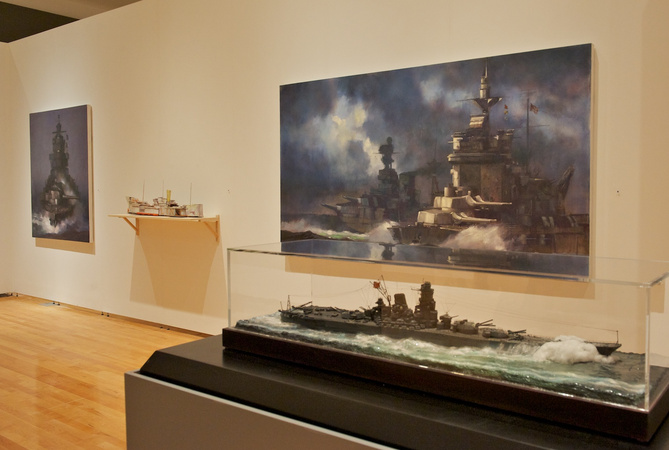(Re)Constructed Warship: Technical Speclations of Grand Naval Monuments
May 2, 2014 – July 1, 2014

Exhibition Details
A test of skill in the service of painstaking historical accuracy meets total fabrication and a disregard of any semblance of literal depiction. The works of Richard Edwards and Chris Flodberg clash in their artistic approach to the same issue: How does an artist, at the mercy of human scale, render monumental emotionally charged machinery “realistically”? Both Edwards’ and Flodberg’s painterly practices are translated onto complex three-dimensional canvases, resulting in the iconoclasm of their naval ship constructions.
Edwards’ sculptures are collage, pieced together in a modernist style, showing not only a perception of a ship but the constructed memory of human relationships to monolithic artifacts. His constructions are reminiscent of both Dazzle Camouflage rendered sculpturally as well as early modernist painting that struggled to render the technological advances brought about by the First World War.
Flodberg applies his meticulous skill of painting to that of the canvas of historical model making. He pays as much attention to the reading of how shadow and light would play at a 1,000 metre distance to the historical research into the accuracy of the lifeboats of a Second World War battleship.
One artist uses the model as a base for the most complex of painting, the other uses the techniques of painting to create models. Both present the folly of these ships. Created by military hubris, the Second World War battleships were obsolete before their constructions were finished—most now rest at the bottom of the ocean. Both renderings are fabrications.
Photography and historical record of battleships are by no means comprehensive, so even Flodberg’s attempts at historical perfection are doomed before they begin. Artistically, they are memento mori in the greatest sense. Flodberg’s pieces are majestic and statuesque monuments to fallen ships, while Edwards ephemeral cardboard works sit unprotected as unfinished facades.
Curated by Lindsey V. Sharman